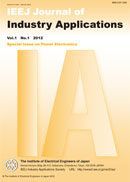Volume 11, Issue 5
Displaying 1-13 of 13 articles from this issue
- |<
- <
- 1
- >
- >|
Paper
-
2022 Volume 11 Issue 5 Pages 643-649
Published: September 01, 2022
Released on J-STAGE: September 01, 2022
Advance online publication: July 08, 2022Download PDF (2533K) -
2022 Volume 11 Issue 5 Pages 650-663
Published: September 01, 2022
Released on J-STAGE: September 01, 2022
Advance online publication: June 17, 2022Download PDF (5690K) -
2022 Volume 11 Issue 5 Pages 664-673
Published: September 01, 2022
Released on J-STAGE: September 01, 2022
Advance online publication: June 03, 2022Download PDF (3669K) -
2022 Volume 11 Issue 5 Pages 674-685
Published: September 01, 2022
Released on J-STAGE: September 01, 2022
Advance online publication: July 08, 2022Download PDF (2693K) -
2022 Volume 11 Issue 5 Pages 686-695
Published: September 01, 2022
Released on J-STAGE: September 01, 2022
Advance online publication: July 15, 2022Download PDF (2518K) -
2022 Volume 11 Issue 5 Pages 696-708
Published: September 01, 2022
Released on J-STAGE: September 01, 2022
Advance online publication: May 27, 2022Download PDF (4372K)
Letter
-
2022 Volume 11 Issue 5 Pages 709-710
Published: September 01, 2022
Released on J-STAGE: September 01, 2022
Advance online publication: May 20, 2022Download PDF (745K) -
2022 Volume 11 Issue 5 Pages 711-712
Published: September 01, 2022
Released on J-STAGE: September 01, 2022
Advance online publication: June 17, 2022Download PDF (607K) -
2022 Volume 11 Issue 5 Pages 713-714
Published: September 01, 2022
Released on J-STAGE: September 01, 2022
Advance online publication: July 15, 2022Download PDF (224K)
Selected and English Translation Paper of IEEJ Trans. IA
-
2022 Volume 11 Issue 5 Pages 715-721
Published: September 01, 2022
Released on J-STAGE: September 01, 2022
Advance online publication: July 29, 2022Download PDF (1180K) -
2022 Volume 11 Issue 5 Pages 722-729
Published: September 01, 2022
Released on J-STAGE: September 01, 2022
Advance online publication: June 24, 2022Download PDF (2989K) -
2022 Volume 11 Issue 5 Pages 730-736
Published: September 01, 2022
Released on J-STAGE: September 01, 2022
Advance online publication: July 08, 2022Download PDF (1972K)
-
2022 Volume 11 Issue 5 Pages L5_1
Published: September 01, 2022
Released on J-STAGE: September 01, 2022
Download PDF (542K)
- |<
- <
- 1
- >
- >|
